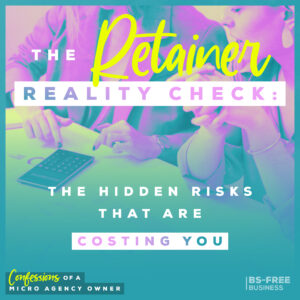
Search the site:
Sorry, Not Sorry: When the Client is Wrong
This just in: the client isn’t always right. I know, shocking, right?
But if you’ve ever had a client who thinks they know more than you, even though they hired you for your expertise, you know exactly what I mean.
In this episode, I’m sharing how to handle those moments when your client is wrong (and maybe even a little delusional), the art of steering them back on course without losing your sanity, and what to do when they just won’t listen.
Today, we’re discussing something we all deal with but rarely discuss out loud: the client is NOT always right.
For most people, this is the first lesson we learn when we get a job. If you’ve ever worked in customer service, it’s been drilled into you.
The idea that the client is wrong goes against everything we’ve been taught, so it’s a hard habit to break.
But when you’re running a solo service business, you’re the expert. You have the skills, knowledge, and experience, and sometimes, the client just doesn’t get it.
They can be wrong, and when they are, it’s on you to set things straight.
Today, I’ll discuss why the customer isn’t always right, how to handle it when they’re wrong, and what to do when things get sticky and the client just won’t listen.
I’m bringing my years of client service experience and communications know-how to arm you with the strategies and just the right words for when you’re ready to tell a client to get a freakin’ clue.
If you’ve ever felt like you had to bite your tongue with a client, this episode is for you. Let’s jump in.
The Customer Isn’t Always Right—Here’s Why
Conventional business wisdom states that “the customer is always right,” but for solo service business owners, this idea can cause some real problems.
Your clients hire you because of your skills and experience, yet it’s not uncommon for them to show up with unrealistic expectations or a lack of understanding. While you can do your best to eliminate these clients during the new business process, sometimes they slip by.
The most common way this shows up is when clients think you can do things faster or cheaper than you actually can. It can feel frustrating (or even disrespectful) when they tell you how to do your job.
Which is WHY they hired you in the first place.
Maybe they don’t understand how long something takes or how complex the work is because they’ve been asking Google or talking to a friend who’s a self-styled expert.
It doesn’t matter why they think what they do, only that you take the time to educate them on what’s involved.
I know it’s tempting sometimes to roll with it, but you need to recognize the potential ramifications of letting them do it their way.
What will it cost you? Will you have to do extra work? Deal with more stress? Will it impact the final result? If the cost is too great, you must be willing to put your foot down.
How to Tactfully Redirect a Client When They’re Wrong
Once you’ve decided the client needs to be corrected, it can be tricky.
On the one hand, you want to get your point across, but on the other hand, you don’t want them to feel dumb or alienated.
The key is leading with empathy, even if you know they’re way off base. “I totally see where you’re coming from,” or “I understand why you might think that” opens the door for a productive conversation rather than a defensive one.
You need to gently remind the client that they hired you for your expertise. For example, “In my experience, this is what works best…” or “Based on what I’ve seen with other clients, I’d recommend a different approach…”
The goal isn’t to shoot them down but to redirect them or offer a better solution. Having an alternative that bettter aligns with their goals, especially backed up with an example, goes a long way to getting them back on track.
Redirection is an art, as you’re not trying to prove them wrong but ensuring they get the best possible solution while maintaining the relationship.
Remember, this takes practice, but it gets easier. I’m at the point where I do this without missing a beat now, and most of the time, I get the response I’m looking for.
What Happens When They Don’t Listen?
It can get messy when the client doesn’t take your strategic counsel. As a team of one, this can feel extra stressful as you don’t have a team backing you up.
First, take a deep breath and do everything you can to avoid reacting in the heat of the moment. When you’re annoyed or irritated, you’re likely to deliver what the client needs to hear in a less than optimal way. (Been there, done that, and it was not pretty.)
When you need to get a client back on track, you’ve got multiple options.
Explain the Risks
Be upfront about the risks of not following your advice. For example, “If we go this route, here are the potential pitfalls: [list specific risks]. It could result in X delays, added costs, or a lower-quality outcome.
You can have a clear conscience if they decide to do what you’ve recommended against. I’ve told clients, “If you choose that path, I will not be responsible for the results.”
Offer Choices
Sometimes, giving the client a choice makes them feel more empowered. Say something like, “We can proceed with your suggestion, but I strongly recommend doing it this way for the best result.”
You’re giving them control, but you’re also protecting yourself by making your stance clear.
Refer Back to the Scope or Contract
This is your safety net. If the client wants to go in a direction that wasn’t agreed upon, refer to the contract. Say, “According to our agreed scope, this is what’s included. If we go in this direction, here’s what it will require.”
That may require altering the timeline, adding more professional fees, or something else. Your scope and contract exist for this exact purpose, so lean on it.
Document Everything
If the client insists on taking the wrong path, document it. Then, follow up with an email recapping your recommendation and their decision.
This protects you if things go sideways later on. You may be pleasantly surprised by how they realize you were right!
Know When to Walk Away
In rare cases, the client may become impossible to work with. They refuse to listen, and it’s affecting your business or mental health.
At this point, it’s okay to cut ties. Yes, it’s uncomfortable, but nothing is worth compromising your business integrity or your sanity.
Let them go and move on to clients who respect your expertise.
Red Flags to Watch for Early On
Now that we’ve discussed handling the client when they’re wrong let’s talk about spotting those red flags early on. Avoiding these situations in the first place makes your life and work so much easier.
Here are some signs that a client might be difficult to manage:
- They question your expertise from the get-go. If a potential client is already challenging your recommendations before the contract is even signed, that’s a huge red flag.
- They focus on cost over value. If they’re obsessed with the cheapest solution rather than the most effective one, expect pushback on your expertise down the line.
- They’re micromanagers. If they want to dictate how every tiny detail of the project goes, you’re in for a tough ride.
- They’ve had bad experiences with other providers. If they’ve bounced from one service provider to another and constantly complain about them, there’s a chance they’ll treat you the same way.
Pay attention to these signals before you say yes to a client. Trust your gut—if something feels off in those early conversations, it probably is.
Stand Your Ground: Expertise Over Ego
Remember, you’re the expert; sometimes, that means telling the client they’re wrong.
It doesn’t have to be confrontational, but it does need to be firm and clear. You’re not in business to take orders; you’re here to provide solutions.
Please don’t be afraid to redirect clients when they’re off base; with a little bit of practice, it becomes much more manageable!
And if they won’t listen? You’ve got the tools to handle it. Use the wording I’ve shared in this episode as a jumping off point for those sticky conversations and have them with the confidence that you’re the expert.

I’m Maggie Patterson (she/her), and services businesses are my business.
I have 20+ years of experience with client services, am a consultant for agency owners, creatives, and consultants, and vocal advocate for humane business practices rooted in empathy, respect, and trust.
Read or Listen to the Latest
Check Out These Posts
For Solo Business Owners

Growing a solo service business is tough.
It’s even harder when you’re bombarded with BS advice that steers you away from your values and why you started your business in the first place.
This is the podcast for solo creatives and consultants who want to remain as a team of one and have zero interest in the hustle and grind of typical business teachings.
Subscribe now and never miss an episode.
For Micro Agency Owners
Most podcasts for agency owners obsess over revenue growth as the ultimate success metric.

But here’s the truth: not everyone wants to make millions. Your goal might be to build a sustainable business that lets you have a life and doesn’t run you into the ground.
Join me as I spill my shameless confessions and share everything I’ve learned about building a micro agency that skips the BS of tired and typical agency teachings.
Follow Now on All Major Podcast Platforms








